Let’s face it, Kodak Portra 400 is the predominant colour negative film of the decade. When Fujifilm inexplicably pulled Pro400H off the market, it left Kodak to dominate the medium-speed colour negative film market. It’s so ubiquitous that those looking for an alternative might be hard pressed to find it. Well with Cinestill 400D we have been provided a warm Californian alternative to Portra’s cool East Coast vibes.
But wait! Isn’t Cinestill ‘just’ Kodak motion picture film repackaged without the remjet layer? Kind of, but there’s a lot more to it than that. Check out their website for further information, because the secret to Cinestill’s success is their high quality conversion of this cine-film for use in still photography. When 400D was released onto the market earlier this year, the community was interested in how ‘Dynamic’ this film really was. The exposure latitude of 400D is supposed to match that of Portra 400 and handle various processes with ease. In this comparison review I won’t exactly be scientific about it (I’ll leave that to the experts!) but hopefully you will get a better idea of how these films worked for me.
Comparison A – Daylight at EI400
The other weekend we had some warm, winter sunshine here in Manchester, so I decided that I would take a walk near Sadler’s Yard and Victoria Station to get some comparison shots of the buildings. Why use architecture for a comparison? Well I don’t know about you, but I find it hard enough to ask a stranger for a portrait, let alone asking them to wait while I use two different cameras. Architecture has the distinct advantage of staying still as a photographic subject! As an excuse for a walk in the sun, and to compare how each film renders the scene, the mixture of modern and older buildings should help display each film’s characteristic.
Ok here’s the only technical bit – each film was exposed at EI 400 using only the internal light meter on both cameras. All pictures on Portra 400 were taken with the Olympus XA which has a 35mm fixed lens. All pictures on Cinestill 400D were taken with the Nikon FM2 and a 50mm f/1.8 pancake lens (review coming soon) You will therefore notice a difference in perspective between each picture, as the different focal lengths frame the scene differently. Finally, both sets of pictures are unedited medium-res scans developed in the Noritsu V30 and scanned on the Noritsu HS1800 at Come Through Lab, Ancoats (cracking job!)
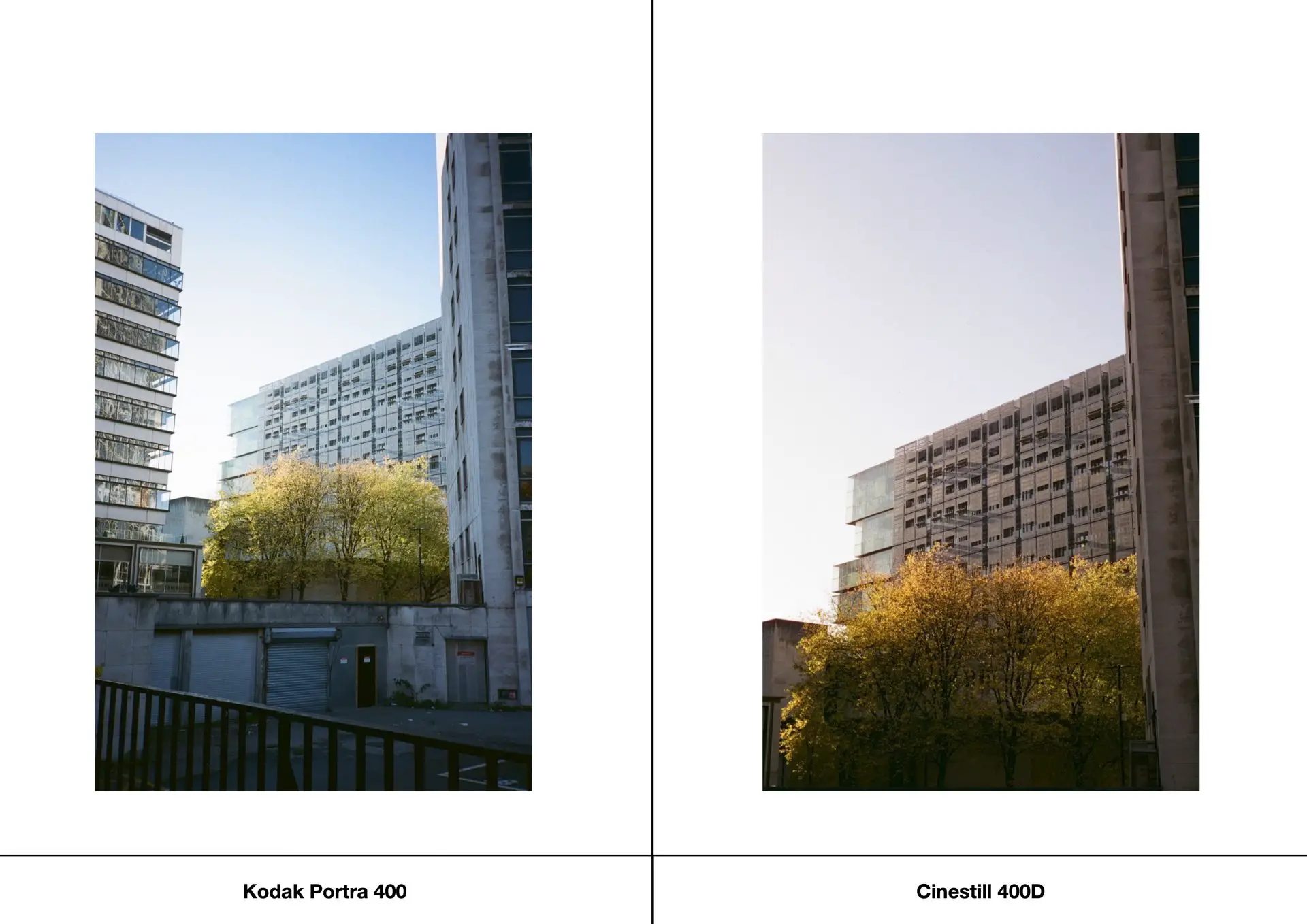
Example 1
Immediately we can see the warmer cast of Cinestill 400D coming through. The colour of the concrete and the metal takes on more of the sun’s warmth.
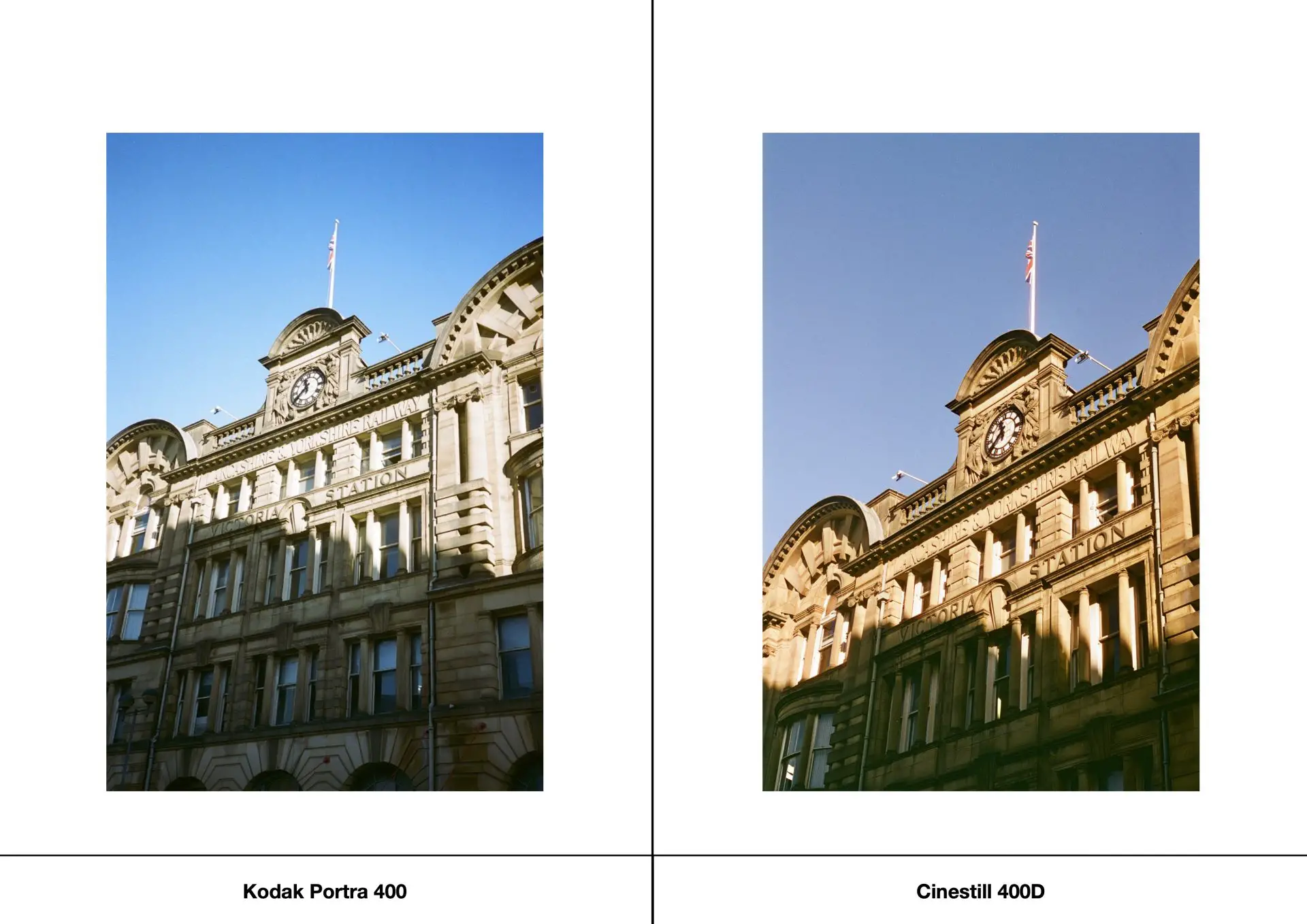
Example 2
Here outside Victoria Station there is more of a visible difference in colour temperature. I prefer the blue sky on Portra 400 but the beautiful stonework of the old station really comes to life on Cinestill 400D in my opinion.
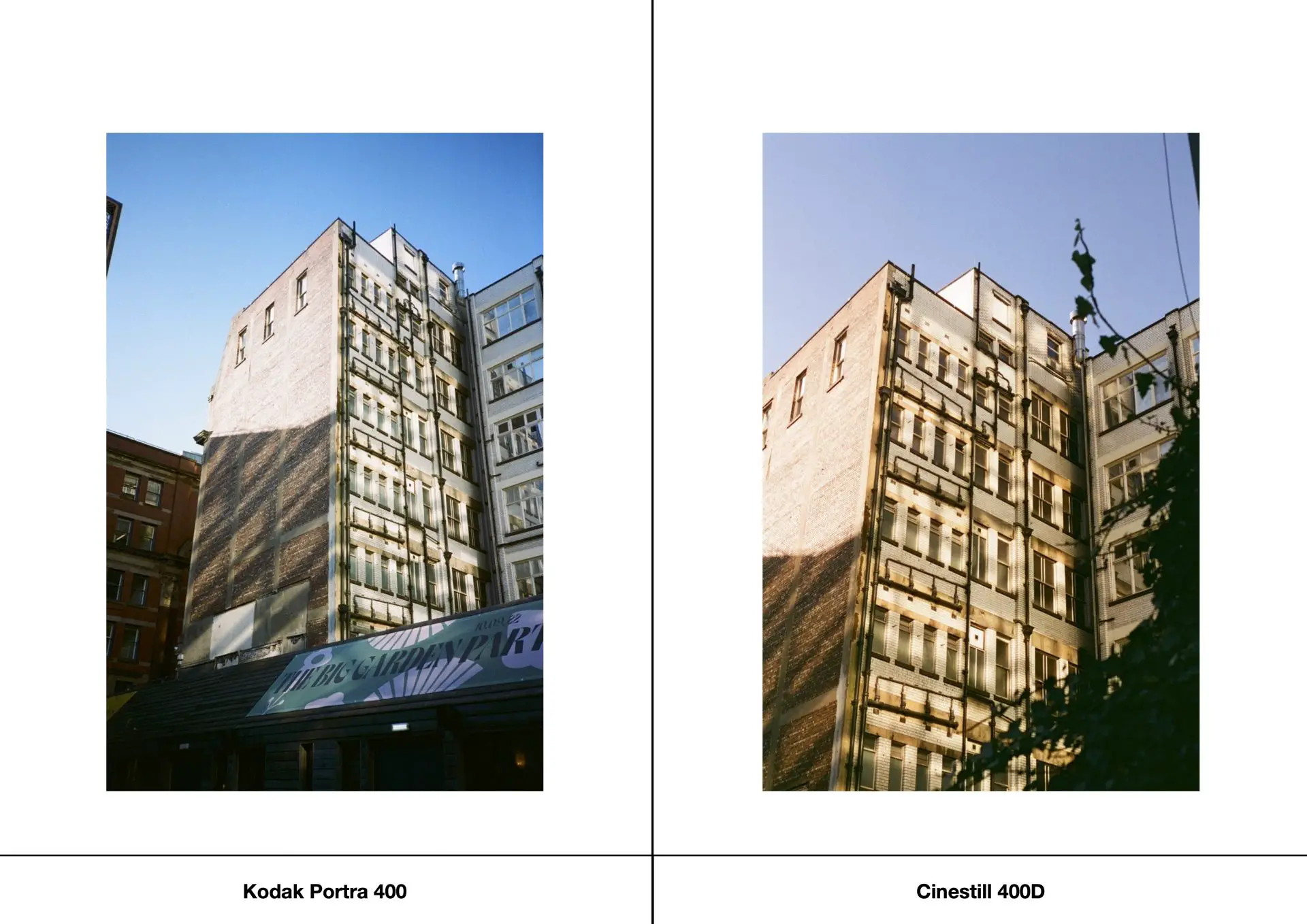
Example 3
Down in Sadler’s Yard the sun reflects off the modern buildings and onto the older brickwork. Again, the cooler de-saturated tones of Portra shine through, and 400D seems to tame a lot of those harsh reflections while softening the sky a bit.
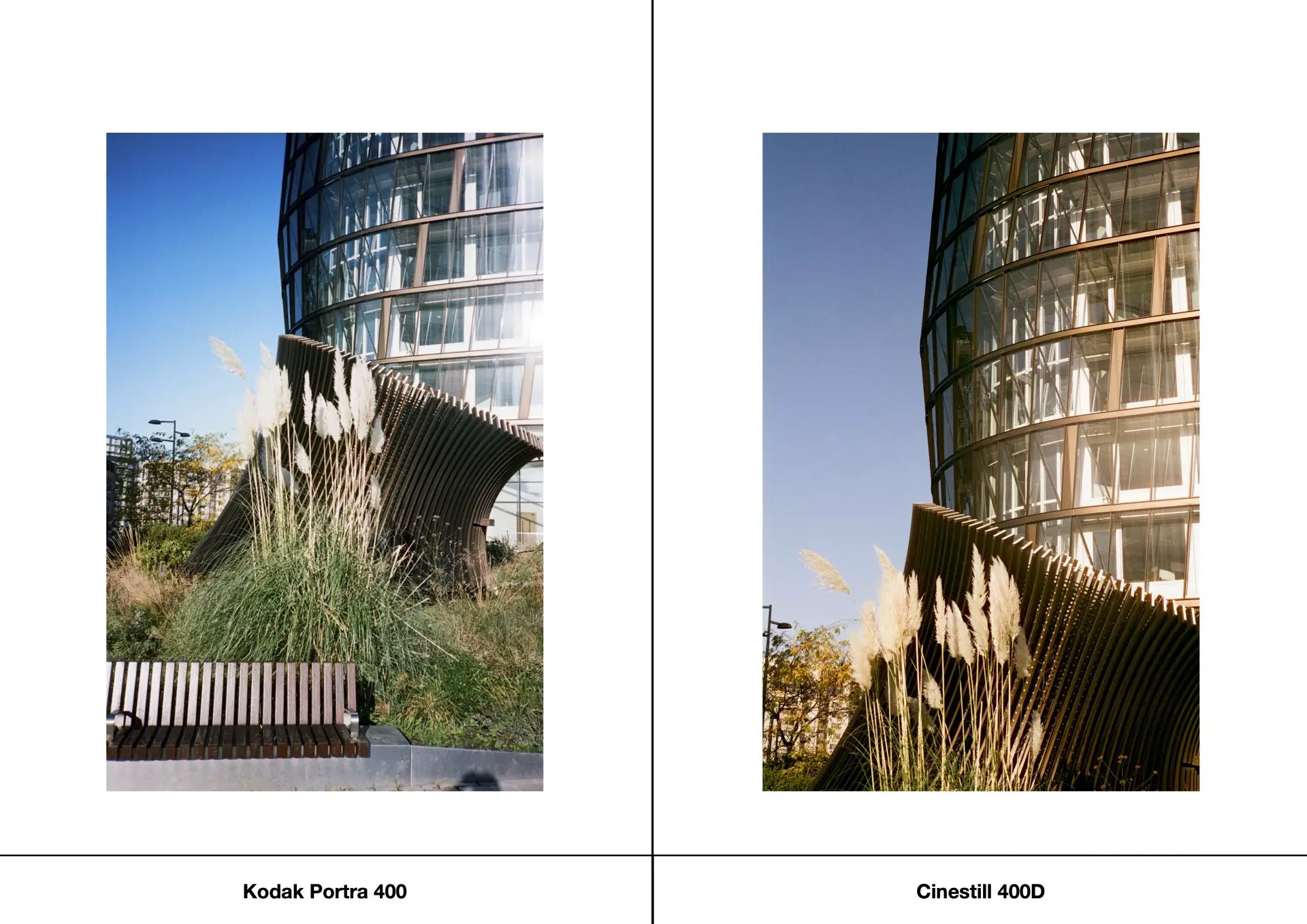
Example 4
One Angel Square is an interesting building with unique design features. It also has these futuristic looking air vents along with the planting. If you look on the right-hand side of each frame you’ll see how the film handles the bright highlights. Exposed at EI400 the infamous halation on Cinestill 400D is only just starting to begin around that area.
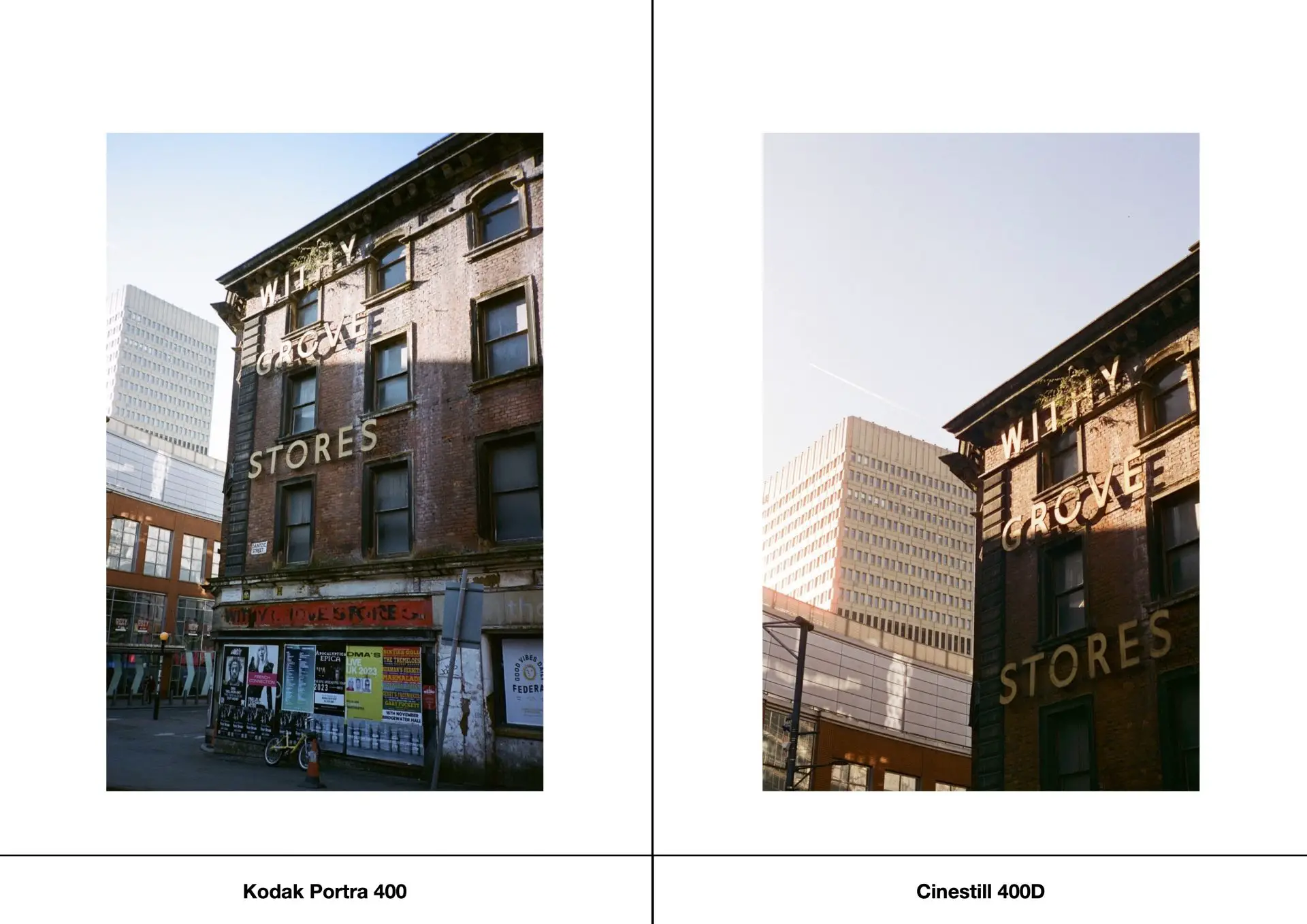
Example 5
Just around the corner from the Arndale Centre are the older buildings of Central Manchester. I just love this signage! Even though both films have very fine grain and good fidelity, the mood of each resulting picture is different. I personally prefer how the warmth of Cinestill 400D adds to the red brick of the older buildings, and the golden colour of the signage letters.
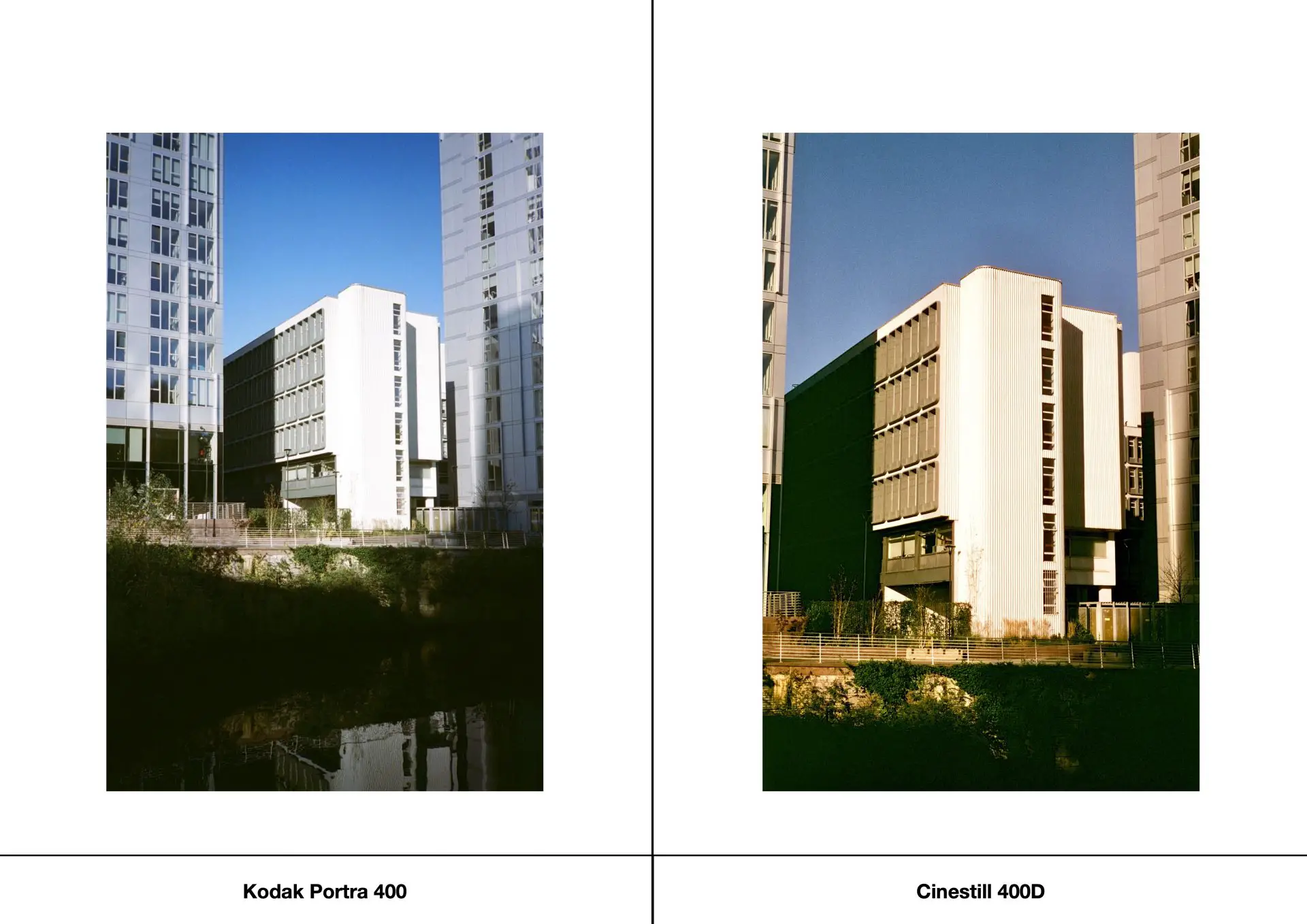
Example 6
Finally this tricky shot in harsh lighting next to the River Irwell, where the extremes of saturation seem to be clearer. The reality of the scene was somewhere in the middle, but who wants reality when we have sweet sweet emulsion.
Comparison B – Fading Light at EI800 pushed one stop
The following weekend it felt like Winter was encroaching on us even more, with the sunlight rapidly disappearing around earlier in the afternoon. I was taking a walk into town to visit Real Camera Co. (top blokes!) and checked out their lovely little shop in the Northern Quarter. I also took advantage of being near the Christmas Markets and the bustle of the city centre to take some photos around Piccadilly Gardens and the surrounding area, so these pictures have a different focus.
I swapped around the two films in my cameras this time, so for this next comparison all pictures on Portra 400 were taken with the Nikon FM2, and those on Cinestill 400D were taken with the Olympus XA instead. As before, you will notice a difference in perspective between each picture because of the focal lengths, and some pictures I have compared side-by-side simply because they share a similar subject. Finally, each film was exposed at EI 800 using only the internal light meter on both cameras, then pushed one stop in development by the fine folks at Come Through Lab, Ancoats on their Noritsu equipment as before.
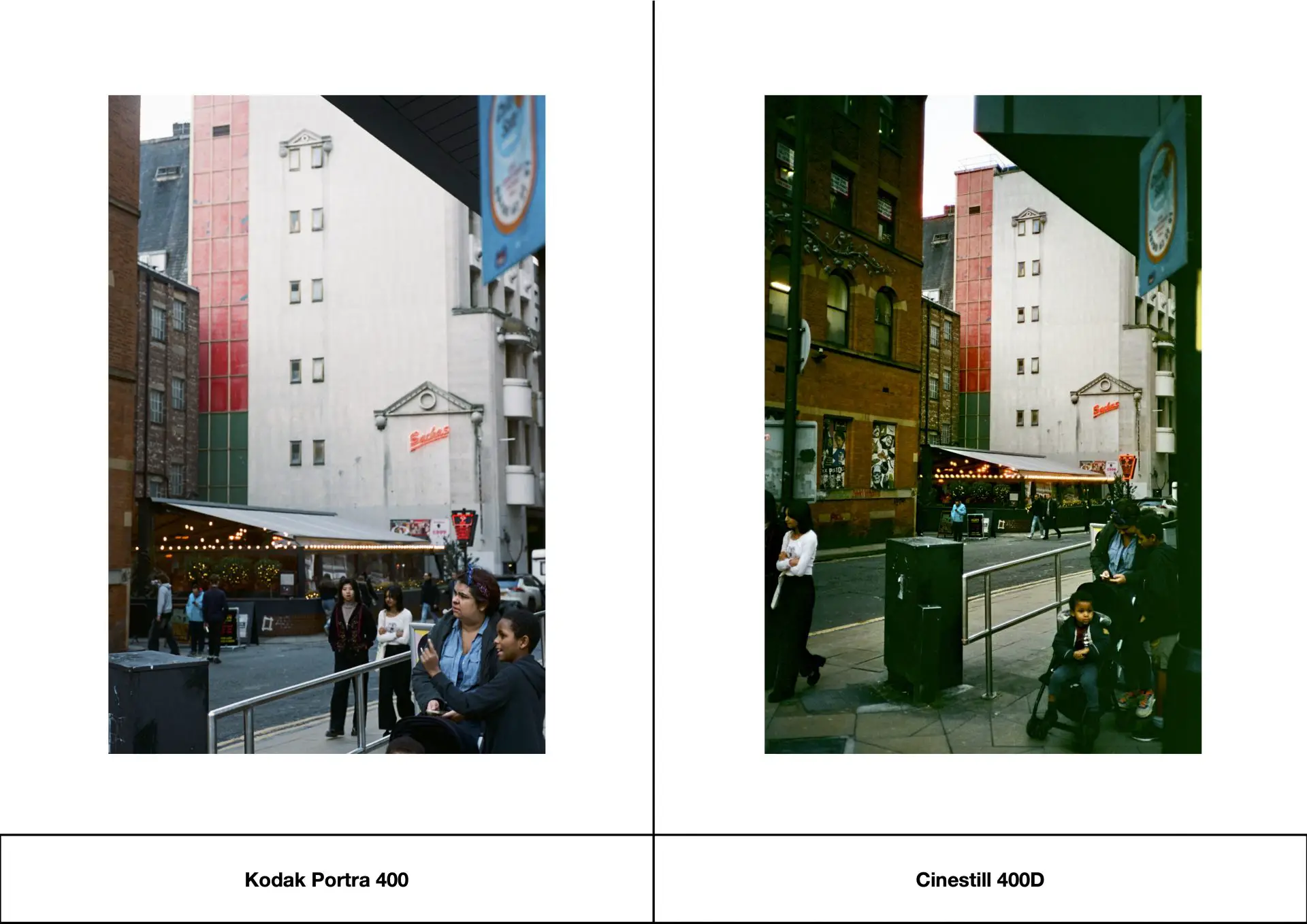
Example 1
Starting in the city near Sachas and next to Afflecks Palace, straight away 400D gives a warmer look to the scene. I like how the reds seem to glow more with 400D, whereas Portra has clearer blues. It already feels like the scene has more colour depth with Cinestill 400D overall, but that with a few tweaks Portra could be made to look similar.
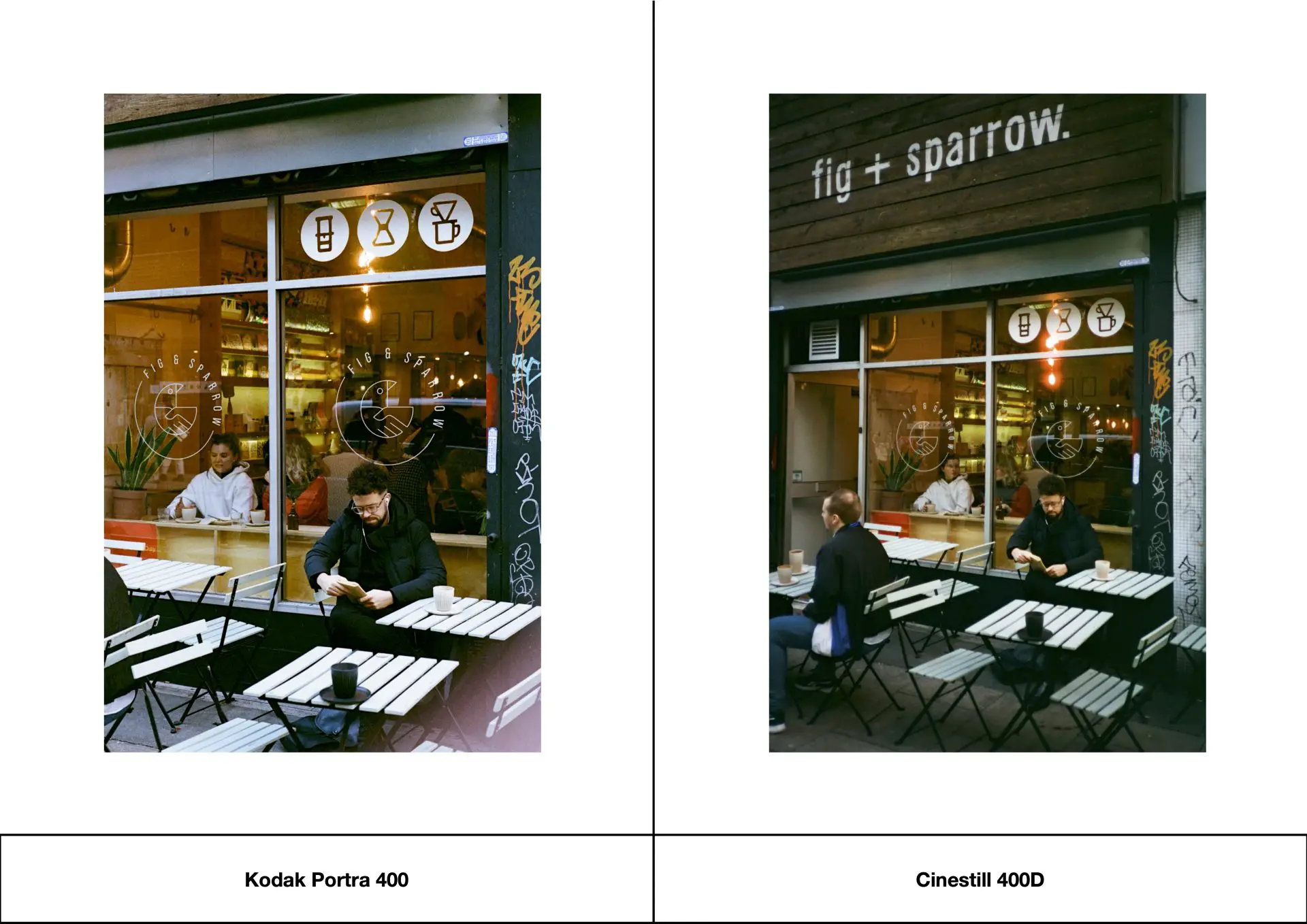
Example 2
I hope I didn’t spoil this guys’ peace outside Fig + Sparrow (another local favourite) but he looked so cool! I like how Portra picks up further detail in the cafe, and really makes that graffiti on the right pop. On the other hand Cinestill 400D really tames the highlights and ‘evens out’ the look of the photo.
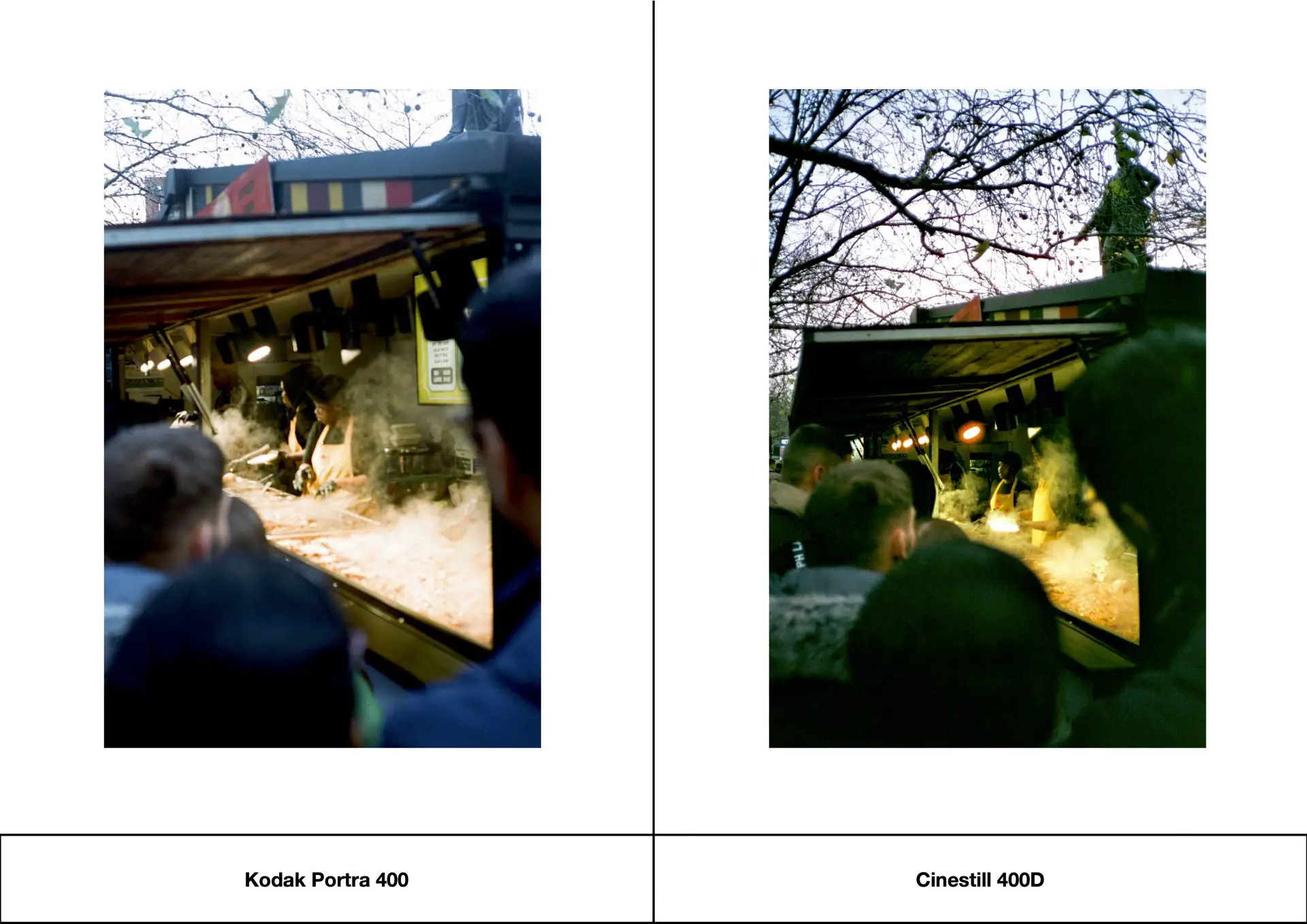
Example 3
Vendors working hard – the steam rising from the kiosks looked fantastic! Ok so I missed focus a bit with my SLR using Portra, but you can see the difference in how the two films render colour from the food up to the flag bunting above.
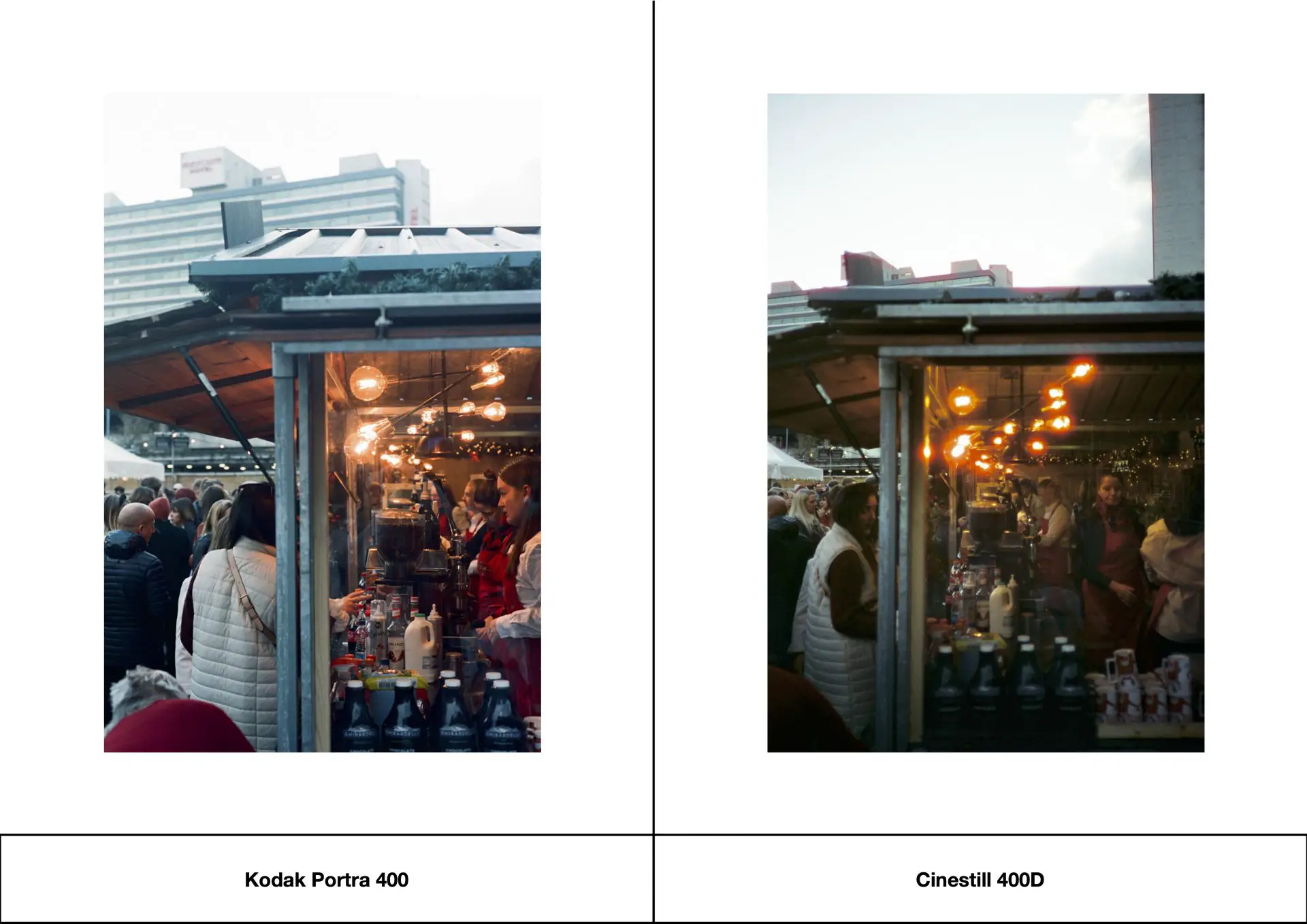
Example 4
Christmas Markets starting up again in Manchester – the detail from Portra really picks up every detail, whereas Cinestill 400D gives more depth and atmosphere to this scene I feel. I reckon this is an example where the signature halation effect really adds to the mood of the photo.
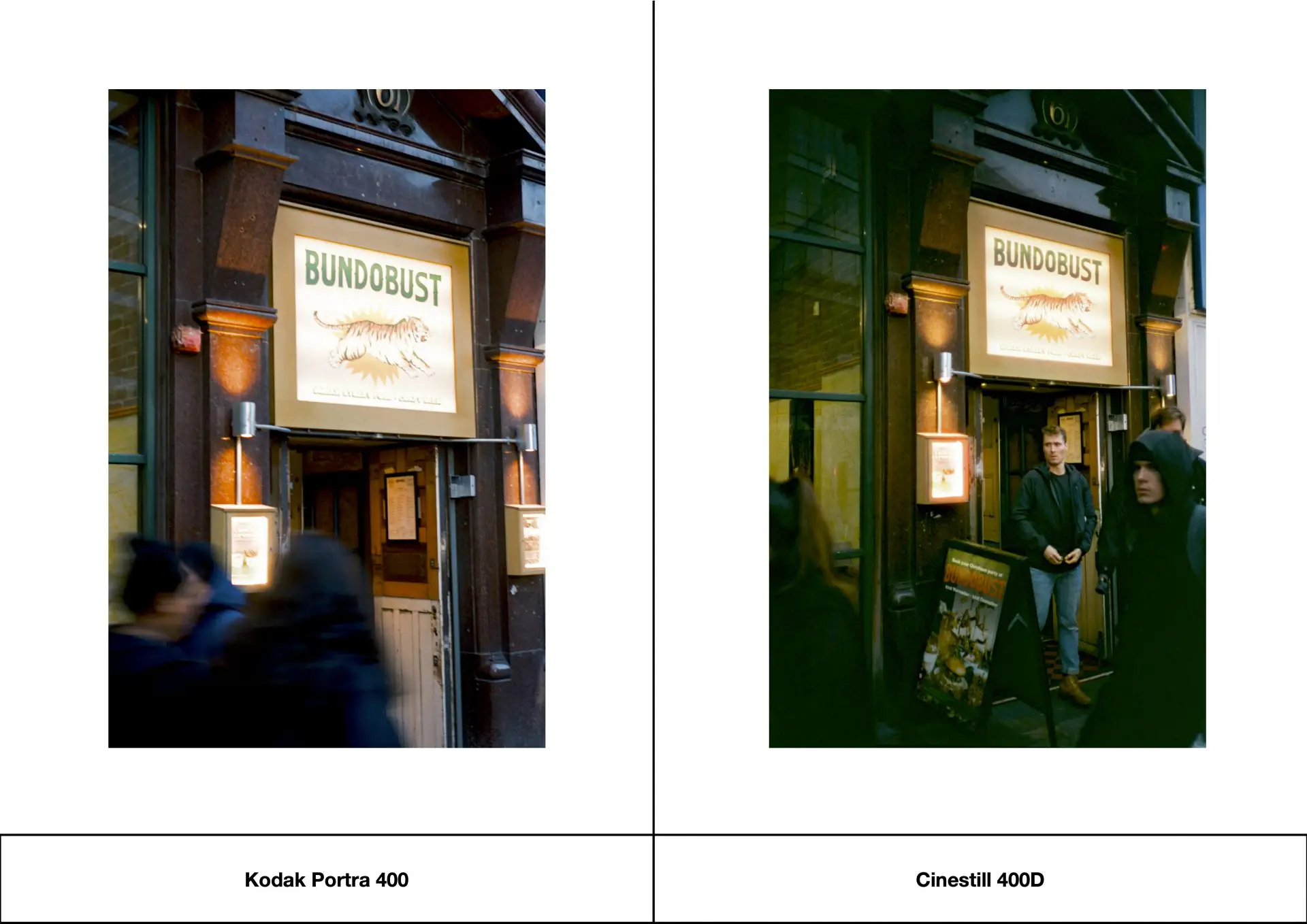
Example 5
Bundobust is one of my absolute favourites for veggie food! The ‘cinematic’ feel of Cinestill 400D shines through in this example, with Portra giving a lot more detail in the shadows around the marble doorway.
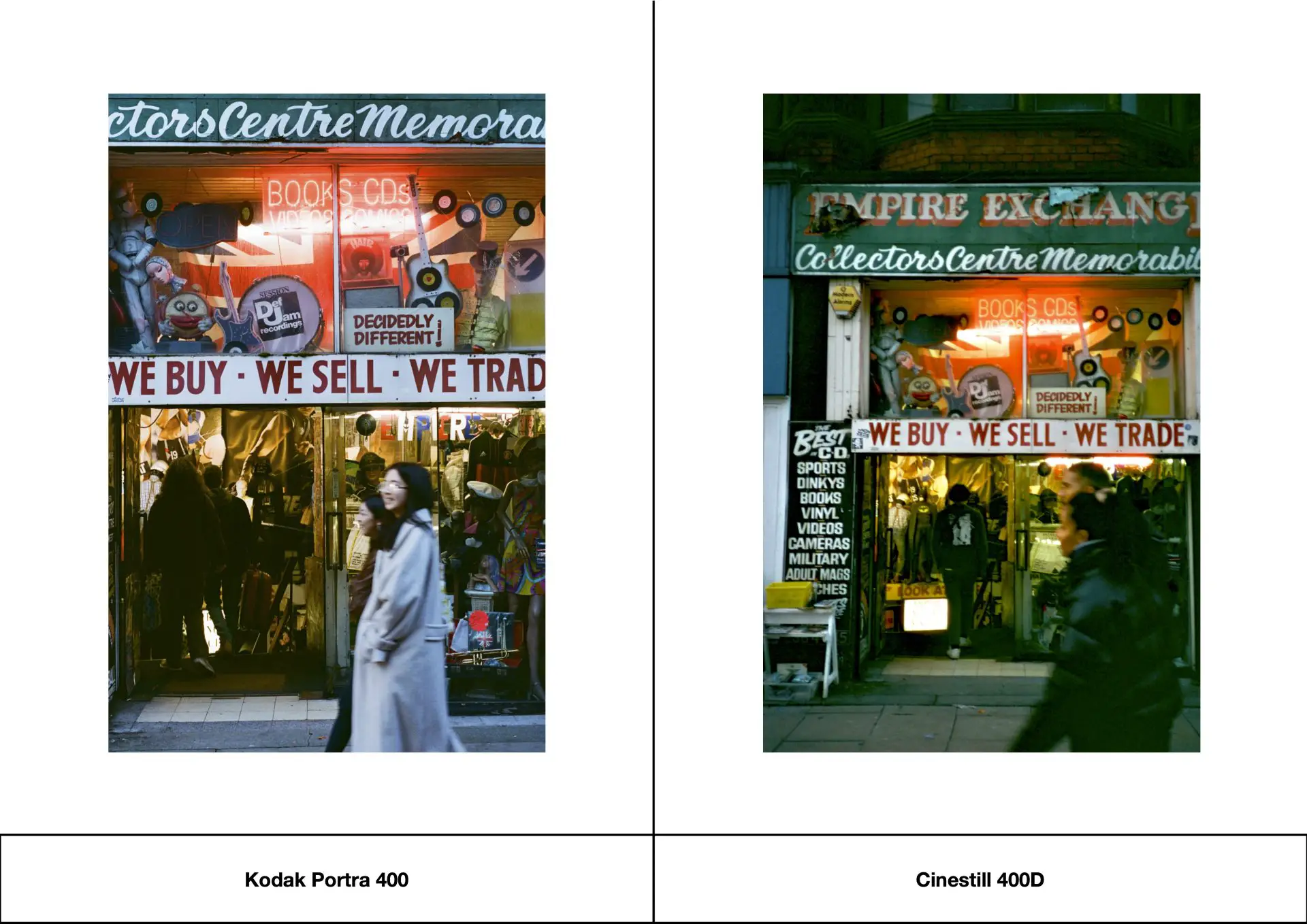
Example 6
I thought I should revisit Empire Exchange Vintage again as it has such a unique-looking window display! The halation effect on 400D is evident around the neon lights, and Portra has a much cleaner look in my opinion.
Conclusion
In my opinion both films have fine and even grain for an ISO 400 speed film, both show excellent fidelity or perceived sharpness, and both stocks are flexible when handling exposure errors in-camera. Each film stock has it’s own identity, and brings its own personality to your pictures. If you like warmth, or are aiming for a ‘vintage’ feel without sacrificing picture quality, then 400D is perfect for setting the scene. Portra 400 on the other hand is a crisp, blank slate of a film that delivers cooler tones, perfect for manipulating on your phone or laptop to achieve whatever ‘look’ you want to achieve.
Personally I’m torn between the two, and it’s honestly all about what kind of ‘vibe’ you want to bake into your pictures with your film choice. Choosing a film stock is different depending on the situation and your intention, but both these films are very flexible, and you can experiment with them to get different results to your liking.
Have you used Cinestill 400D yet? Are you tempted to try it out, if so for what situation? Let me know in the comments below.
All scans were developed and processed by Come Through Lab in Ancoats, Manchester.
Find them on instagram here: @comethroughlab
Thanks for reading, and I look forward to sharing more of my photos and experiences with this community soon.
You can find me on Instagram: @tedayre
Share this post:
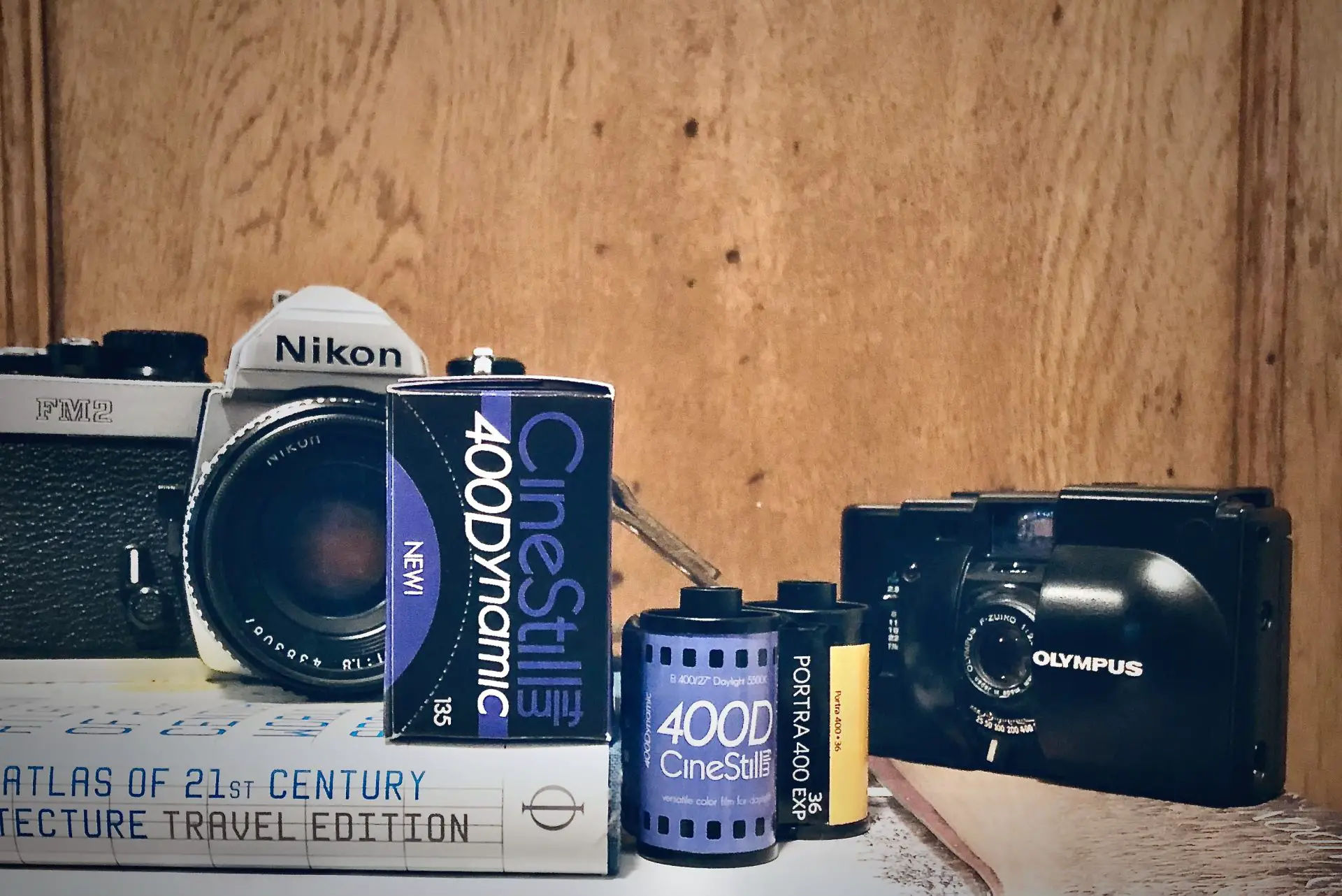








Comments
Stephen Meese on Cinestill 400D vs Kodak Portra 400 – Film Review – By Ted Ayre
Comment posted: 21/12/2022
Comment posted: 21/12/2022
Steve Macfarlane on Cinestill 400D vs Kodak Portra 400 – Film Review – By Ted Ayre
Comment posted: 21/12/2022
Comment posted: 21/12/2022
Ilya on Cinestill 400D vs Kodak Portra 400 – Film Review – By Ted Ayre
Comment posted: 22/12/2022
Comment posted: 22/12/2022
Gary on Cinestill 400D vs Kodak Portra 400 – Film Review – By Ted Ayre
Comment posted: 22/12/2022
Comment posted: 22/12/2022
Wes Hall on Cinestill 400D vs Kodak Portra 400 – Film Review – By Ted Ayre
Comment posted: 22/12/2022
Will have to try some as I love warm tones.
Comment posted: 22/12/2022
Shaun Edwards on Cinestill 400D vs Kodak Portra 400 – Film Review – By Ted Ayre
Comment posted: 25/12/2022
I’ve shot with Vision 250d that had the remjet but wasn’t that keen on the results but I think that was down to the lab that did the ECN2 processing. Their scans were awful. They came out a lot better when I did my own with my dslr
I really do need to give some Cinestill a try soon.
Great images from the XA but we already know what a fantastic camera that is!
Comment posted: 25/12/2022
Dave Luttmann on Cinestill 400D vs Kodak Portra 400 – Film Review – By Ted Ayre
Comment posted: 26/12/2022
Comment posted: 26/12/2022
Nick on Cinestill 400D vs Kodak Portra 400 – Film Review – By Ted Ayre
Comment posted: 27/12/2022
The colour differences between Portra400 and 400D that you've shown in the article are all easily within the scope of scanning workflow. Ie. a subtle tweek to a colour temp slider here and there would show 400D to be the cool option and Portra to be swimming in warm tones. Different scanners, software and scanning techs will influence the outcome so much that comparisons almost become redundant. I find it interesting how committed many modern film photographers are to the 'look' or certain films when truisms like 'Pro400H has a green caste' is only a click away from being bollocks...
Where comparisons do become really interesting is in things like scan-ability, latitude, halation (in the case of the Cinestill stocks) dynamic range and so on.
Comment posted: 27/12/2022